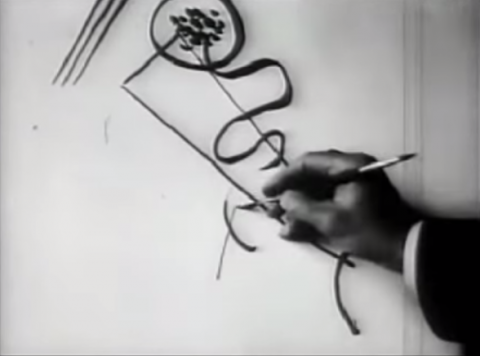Have you ever wondered what it would be like to travel back in time and look over the shoulder of one of the early 20th century’s greatest artists to watch him work? In this brief film from 1926, we get to see the Russian painter Wassily Kandinsky as he turns a blank canvas into one of his distinctive abstract compositions.
The film was made at the Galerie Neumann-Nierendorf in Berlin by Hans Cürlis, a pioneer in the making of art documentaries. At the time the film was made Kandinsky was teaching at the Bauhaus. It was the same year he published his second major treatise, On Point and Line to Plane. The contrasting straight lines and curves that Kandinsky paints in the movie are typical of this period, when his approach was becoming less intuitive and more consciously geometric.
Kandinsky believed that an artist could reach deeper truths by dispensing with the depiction of external objects and by looking within, and despite his analytic turn at the Bauhaus he continued to speak of art in deeply mystical terms. In On Point and Line to Plane, Kandinsky writes:
The work of Art mirrors itself upon the surface of our consciousness. However, its image extends beyond, to vanish from the surface without a trace when the sensation has subsided. A certain transparent, but defininite glass-like partition, abolishing direct contact from within, seems to exist here as well. Here, too, exists the possibility of entering art’s message, to participate actively, and to experience its pulsating life with all one’s senses.
Related content:
The Inner Object: Seeing Kandinsky
Vintage Footage of Picasso and Jackson Pollock Painting … Through Glass



Such an elegant insight into the intricate yet elusive nature of art…Beautiful.
I don’t know much about art, but I know doodling when I see it.
Doodling is a method of creating art. So you do know something about art.
awesome
So deep, so unconscious, so subjective…extremly wonderful!!!
It is doodling at the highest level. He is famous for a reason.
Did this painting get finished ? If so what was it’s name and where is it now ?
Happy Cappy products are designed to be gentle and effective, and are free from harsh chemicals such as sulfates, parabens, and fragrance, which can irritate sensitive skin. The products contain active ingredients such as pyrithione zinc, which helps to control the growth of yeast on the skin, and salicylic acid, which helps to exfoliate the skin and remove scales.